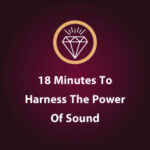Most of us grew up learning that the human body has five senses: sight, sound, touch, taste and smell. Everything we know about the world around us comes to us through these senses. We see colors and we hear music. We taste whether our coffee has sugar in it and, especially now that we’re heading into summer, we smell the flowers and feel the warm air. But the world isn’t really divided up as neatly into those senses as it might seem. Depending on how you look at it, we might have anywhere from just three senses to thirty-three or more; they can mix together and split apart in ways that we don’t usually think about. Sound in particularly is really just vibrations filling the air around us, and that simple fact can lead to some fascinating discoveries if we look and listen closer.
Can you see sound? It might seem like the answer is no, but if it’s loud enough, you may notice a window shaking or even feel the floor trembling under your feet. But the truth is that everything carries sound and vibrates with it, even if we can’t normally see it. A few years ago researchers at MIT developed an algorithm they call a “visual microphone,” that can scan video footage to observe the way sound causes everyday objects to invisibly vibrate and then reproduce those sounds. Check out this video for a demonstration of how a houseplant vibrates with the song “Mary Had a Little Lamb,” and how that song can be recreated using those silent vibrations.
Everything around us is humming with sound, even if we don’t always notice it. If the frequency’s too low, we might sense the sound without actually hearing it. Such low, deep sounds are called infrasound and even though we can’t hear them, animals use them for everything from traveling in herds to migrating in the winter to sensing earthquakes and eruptions. And although we can’t directly hear infrasound, we can sense when it’s there, as a vague feeling that something’s making us uncomfortable. Researchers think it might be the reason some houses seem to be haunted, and horror movies have started using infrasound to create a more ghostly atmosphere.
I’ve linked to a video here of a 19Hz infrasound clip if you’d like to hear, or feel, it for yourself. You’ll need headphones to play back such a low frequency, and be careful: you might end up feeling nervous, dizzy or even a little sick to your stomach.
Most of us spend every moment of our lives surrounded by sound, so what happens when all of that sound’s taken away? The answer can be found in an anechoic chamber, a soundproof room that’s designed to absorb all sounds, both inside and out. Two such rooms, one at Orfield Labs in Minneapolis and the other at Microsoft’s headquarters in Redmond, hold the record as the quietest places on Earth. They’re so quiet that nobody’s ever stayed inside one for more than an hour. Even walking can be a challenge without any footsteps, and hearing nothing but the sound of your own heart, your stomach, even your bones, ends up being too much.
When you’re ready for some noise, though, there’s one animal that’s not only one of the loudest creatures in the ocean, but also one of the smallest. It’s called the snapping shrimp, and it measures just a few centimeters from head to tail. It uses sound as a weapon, launching superheated bubbles through the water that burst at over 200 decibels, louder than a blue whale. These bubbles are so loud that they can even drown out submarines and sonar equipment.
So, can we see sound? The sound of a snapping shrimp’s claw can be so loud that it literally creates a burst of light, but there’s a safer way to view sound waves for ourselves. It’s known as cymatics, the study of sound visualization, and it uses everything from flowing water to grains of sand to help reveal the invisible patterns that sound creates all around us. Be sure to check the video below for an exciting music video by electronic composer Nigel Stanford called “Cymatics” that shows just how many different forms music can take.
Whether we’re walking along the beach or just stuck in traffic, listening to music or enjoying the peace and quiet, we’re immersed in a flowing sea of sound, a secret symphony of complex patterns and vibrations hidden just below the surface of what we hear.
Would you consider giving this podcast an honest review? You can do that here: https://lovethepodcast.com/audiobranding. And if you like what you hear (and read!) – please do share it with anyone you think might be interested. Thanks so much!
And if you’re interested in crafting an audio brand for your business, why not check out my FREE download – 5 Tips For Implementing An Intentional Audio Strategy at https://voiceoversandvocals.com/audio-branding-strategy/

